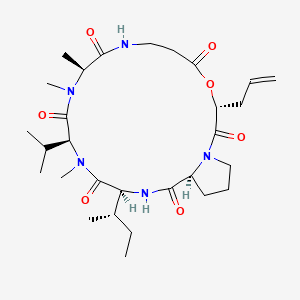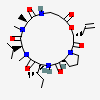Destruxin A
- Destruxin A
- 6686-70-0
- UNII-255H1K2LFG
- 255H1K2LFG
- DESTRUXIN DA
- Create:2006-10-26
- Modify:2025-01-18


- destruxin A
- destruxin DA
- Destruxin A
- 6686-70-0
- UNII-255H1K2LFG
- 255H1K2LFG
- DESTRUXIN DA
- (3R,10S,13S,16S,19S)-16-[(2S)-butan-2-yl]-10,11,14-trimethyl-13-propan-2-yl-3-prop-2-enyl-4-oxa-1,8,11,14,17-pentazabicyclo[17.3.0]docosane-2,5,9,12,15,18-hexone
- NSC 361126
- BRN 0601694
- NSC-361126
- Destruxin A from Metarrhizium anisopliae
- SB-242533
- (3R,10S,13S,16S,19S)-10,11,14-trimethyl-13,16-di(propan-2-yl)-3-prop-2-enyl-4-oxa-1,8,11,14,17-pentazabicyclo(17.3.0)docosane-2,5,9,12,15,18-hexone
- (3R,10S,13S,16S,19S)-10,11,14-trimethyl-13,16-di(propan-2-yl)-3-prop-2-enyl-4-oxa-1,8,11,14,17-pentazabicyclo[17.3.0]docosane-2,5,9,12,15,18-hexone
- (3R,10S,13S,16S,19S)-16-((2S)-butan-2-yl)-10,11,14-trimethyl-13-propan-2-yl-3-prop-2-enyl-4-oxa-1,8,11,14,17-pentazabicyclo(17.3.0)docosane-2,5,9,12,15,18-hexone
- CHEMBL4524055
- CHEBI:184039
- HY-N6689
- DA-52465
- MS-30389
- CS-0099705
- Q27253912

H302 (100%): Harmful if swallowed [Warning Acute toxicity, oral]
H312 (100%): Harmful in contact with skin [Warning Acute toxicity, dermal]
H315 (100%): Causes skin irritation [Warning Skin corrosion/irritation]
H319 (100%): Causes serious eye irritation [Warning Serious eye damage/eye irritation]
H332 (100%): Harmful if inhaled [Warning Acute toxicity, inhalation]
H335 (100%): May cause respiratory irritation [Warning Specific target organ toxicity, single exposure; Respiratory tract irritation]
P261, P264, P264+P265, P270, P271, P280, P301+P317, P302+P352, P304+P340, P305+P351+P338, P317, P319, P321, P330, P332+P317, P337+P317, P362+P364, P403+P233, P405, and P501
(The corresponding statement to each P-code can be found at the GHS Classification page.)
Aggregated GHS information provided per 38 reports by companies from 1 notifications to the ECHA C&L Inventory. Each notification may be associated with multiple companies.
Information may vary between notifications depending on impurities, additives, and other factors. The percentage value in parenthesis indicates the notified classification ratio from companies that provide hazard codes. Only hazard codes with percentage values above 10% are shown.
Acute Tox. 4 (100%)
Acute Tox. 4 (100%)
Skin Irrit. 2 (100%)
Eye Irrit. 2 (100%)
Acute Tox. 4 (100%)
STOT SE 3 (100%)
- ChEBI
- LOTUS - the natural products occurrence databaseLICENSEThe code for LOTUS is released under the GNU General Public License v3.0.https://lotus.nprod.net/Destruxin Ahttps://www.wikidata.org/wiki/Q27253912LOTUS Treehttps://lotus.naturalproducts.net/
- ChEMBLLICENSEAccess to the web interface of ChEMBL is made under the EBI's Terms of Use (http://www.ebi.ac.uk/Information/termsofuse.html). The ChEMBL data is made available on a Creative Commons Attribution-Share Alike 3.0 Unported License (http://creativecommons.org/licenses/by-sa/3.0/).http://www.ebi.ac.uk/Information/termsofuse.html
- ChemIDplusChemIDplus Chemical Information Classificationhttps://pubchem.ncbi.nlm.nih.gov/source/ChemIDplus
- European Chemicals Agency (ECHA)LICENSEUse of the information, documents and data from the ECHA website is subject to the terms and conditions of this Legal Notice, and subject to other binding limitations provided for under applicable law, the information, documents and data made available on the ECHA website may be reproduced, distributed and/or used, totally or in part, for non-commercial purposes provided that ECHA is acknowledged as the source: "Source: European Chemicals Agency, http://echa.europa.eu/". Such acknowledgement must be included in each copy of the material. ECHA permits and encourages organisations and individuals to create links to the ECHA website under the following cumulative conditions: Links can only be made to webpages that provide a link to the Legal Notice page.https://echa.europa.eu/web/guest/legal-noticeDestruxin A (EC: 636-280-1)https://echa.europa.eu/information-on-chemicals/cl-inventory-database/-/discli/details/168913
- FDA Global Substance Registration System (GSRS)LICENSEUnless otherwise noted, the contents of the FDA website (www.fda.gov), both text and graphics, are not copyrighted. They are in the public domain and may be republished, reprinted and otherwise used freely by anyone without the need to obtain permission from FDA. Credit to the U.S. Food and Drug Administration as the source is appreciated but not required.https://www.fda.gov/about-fda/about-website/website-policies#linking
- Japan Chemical Substance Dictionary (Nikkaji)
- The Natural Products AtlasLICENSEThe Natural Products Atlas is licensed under a Creative Commons Attribution 4.0 International License.https://www.npatlas.org/termsThe Natural Products Atlas Classificationhttps://www.npatlas.org/
- Metabolomics Workbench
- Wikidatadestruxin ahttps://www.wikidata.org/wiki/Q27253912
- PubChem
- Medical Subject Headings (MeSH)LICENSEWorks produced by the U.S. government are not subject to copyright protection in the United States. Any such works found on National Library of Medicine (NLM) Web sites may be freely used or reproduced without permission in the U.S.https://www.nlm.nih.gov/copyright.htmldestruxin Ahttps://www.ncbi.nlm.nih.gov/mesh/67040423Insecticideshttps://www.ncbi.nlm.nih.gov/mesh/68007306
- GHS Classification (UNECE)GHS Classification Treehttp://www.unece.org/trans/danger/publi/ghs/ghs_welcome_e.html
- MolGenieMolGenie Organic Chemistry Ontologyhttps://github.com/MolGenie/ontology/

